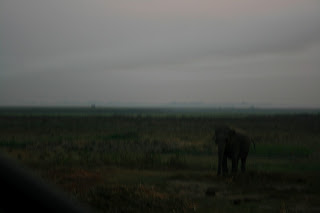1. Saraswati Puja is another festival here. It celebrates the goddess of education and knowledge and was held on Friday, Feb 15. I think that is a good omen for the future of the Lakhtokia kids' education (and it is worth mentioning that I prayed to her for help and advice). The celebrations are held in any place that offers services related to young people and education, from pre-schools to colleges. These schools will gather their current students and alumni together to celebrate Saraswati. And throughout the day individuals and families will make offerings to her.
 |
| Saraswati |

Also on Saraswati Puja, every woman dresses up in a new sari or mekhala chaddar (which is the Assamese version of a sari). And when I mean they get dressed up, I mean dressed to the nines. They are supposed to look absolutely beautiful on this day. Almost EVERY single female of ALL ages has on a sari or mekhala chaddar, which is not usually the case.
To celebrate, I wore a mekhala chaddar all day long like all the other females. I thought I got a lot of stares for being a foreigner, but being a foreigner in a traditional Indian outfit gets every single eye on you. I first went to the Don Boscoe School, where the afternoon school program invited me to take part in their festivities. I worshiped Saraswati Puja and ate delicious Kitchari, which is traditional Puja food.


 |
| Don Boscoe School celebrating Saraswati Puja. |
 |
| Friends! |
 |
| Handique Girls College |
 |
| Worshipping Saraswait Puja. |
 |
| Kitchery time (notice the beautiful colors). |
I also saw six couples holding hands that day. That is more couples holding hands than I have seen altogether in the past five months I have been here.
2. Remember Renuka? The girl whose uncle pulled her out of her abusive home and got her surgery at the hospital? Well, Menakshi (the child life intern) and I have had a hard time getting her and her uncle back to the center for follow up because of money issues. Yes, Operation Smile reimburses the patient, but patients still have a hard time getting money together to pay for the transportation here. So, after Menakshi and I dug up their phone number from their medical file and made repeated phone calls to them, Alison Smyth came to the rescue.
Alison Smyth is a volunteer from Ireland who writes patient stories for Operation Smile. She came back to Assam to complete an eight-month follow-up interview with several patients. After filling Alison
in on Renuka’s story, Alison decided that she would try and fit in a visit to Renuka’s house on her travels. Alison got to visit Renuka, and she started school today, Monday, February 18! Thank you Saraswati. Good luck Renuka on your second day (even though you do not need it).
3. Remember Rupa? Rupa and her family live below the hospital. I see Rupa and her siblings every day and love playing with these adorable, energetic children. Recently, MMC Hospital, which is where GC4 is located, got taken over by the biggest and best hospital in Guwahati: GMC Hospital. As a result, there are lots of changes being made to the hospital. (The hospital has never been as clean as it is now.)
But the new ownership has kicked Rupa and her family out because their house is no longer there. What used to be shack under the wheelchair ramp is now just empty space.
Every time I walk past their house, I am used to waving and yelling with a big smile, “Hello Rupa, Hello Shamir.” I am used to the kids running out, waving, and giving a high five. But now, I turn to my
right and there is no one to wave to, or smile to, or play with. I cannot stop thinking about where they have gone. They did not have anywhere to go. The hospital was their longtime home. A comfortable,
familiar home—that’s all this LARGE family wanted.
4. I am now in Kolkata for an Operation Smile International Mission. After Kolkata, I will be traveling to Agra (to see the Taj Mahal) and Delhi (to meet my parents). Then, I will return to Guwahati to show my parents what I have been up to. Mom, be sure to bring motion sickness medicine… the driving is crazy! And following our stay in Guwahati, we will go north to the beautiful tea town of Darjeeling.
I am sad that I have to leave at a time when the girls from Lakhtokia are beginning to go to school. At the same time, I feel that this break has come at a perfect time when my empathy for these children is overwhelming and I can have time to think about the best options as far as education goes for these kids.
Sending smiles from India,
Hannah











































